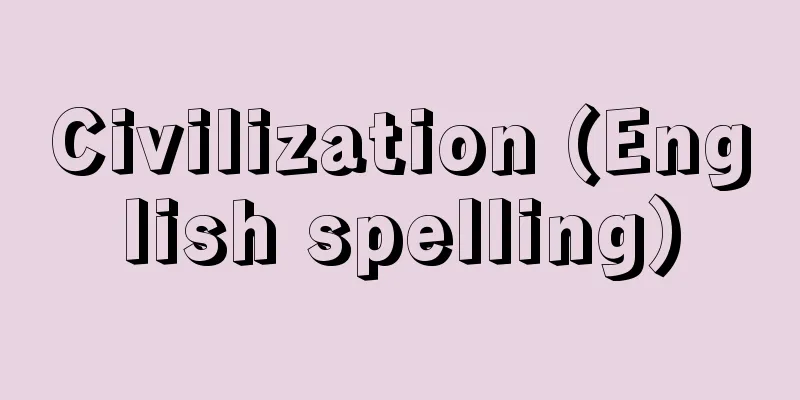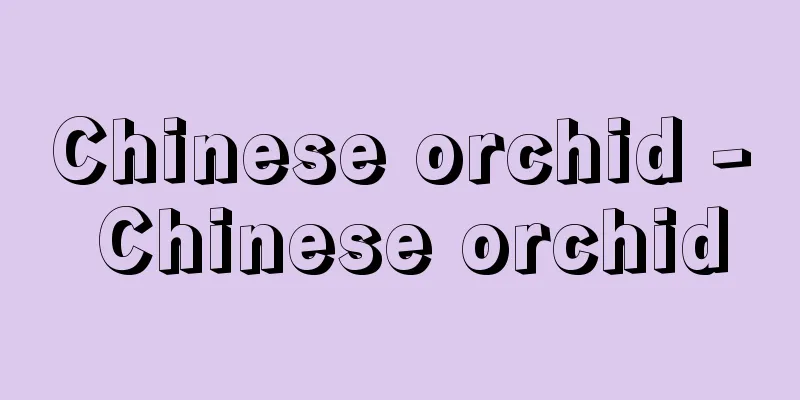Civilization (English spelling)

|
In Japan, the words "bunmei" (civilization) and "ka" (modernization) began to be used almost in parallel in the early Meiji period, and the combination of the two, "bunmei ka" (civilization and modernization), became a slogan for modernization and Westernization. Both words are translations of the word "civilization," which comes from the Latin words civis (citizen), civilis (citizen), and civitas (city). From the mid-Meiji period to the Taisho period, the word "ka" was removed from "bunmei ka" (civilization and modernization) to become "bunmei," and around this time, the word "culture" as it is used today also began to be used widely. There are two trends in the use of the words civilization and culture. The first is that civilization and culture are continuous, and that a culture that is accompanied by urbanization, advanced technology, social differentiation, and class differentiation is a civilization. Each culture and each civilization exists on Earth in a pluralistic way, with its own individuality and uniqueness, and it is said that the majority of tribal cultures on Earth transitioned to pre-modern urban civilization and then to modern urban civilization. This way of thinking became common in Japan as cultural anthropology became more widespread after the Second World War. On the other hand, the second way of thinking has been prevalent in Japan since before the war. This way of thinking does not consider civilization and culture to be continuous, but rather to be in opposition, with culture being the spiritual product and civilization being the material product. In Western Europe, civilization has long referred to both today's "civilization" and "culture," but since the first usage was proposed by German ethnologists and British anthropologists in the late 19th century, many anthropologists have avoided the second usage. The second usage is strongly influenced by German philosophy, especially the Neo-Kantian school. This holds that while material and technological civilization accumulates and develops, spiritual and value culture is a one-off and cannot be measured by the standards of progress. From a slightly different perspective, some, like the 18th century French Enlightenment school, claim that the stage following feudalism and monarchy is the stage of civilization, that is, the stage of civil society, and others, like Morgan in the United States, claim that civilization follows savagery and barbarism. This idea of dividing civilization into stages of development is based on social evolutionism, which is now rejected. On the other hand, the second usage is still deeply rooted in the terms material civilization and spiritual culture, which are widely used in Japanese. Until recently, some diagrams of world history (for example, Oriental civilization → Greek civilization → Roman Mediterranean civilization → Western civilization) were presented as a linear series, roughly in stages of development, and were based on a Western-centered view of world history. However, it was Spengler who gave a trigger for a broader ideological shift in this view. He listed eight advanced cultures in the world, including non-Western regions (Egypt, Babylonia, India, China, Greece and Rome, Arabia, Mexico, and Western Europe), and said that each of them, as an independent organism, went through the process of birth, growth, decline, and death, with the final stage being "civilization." He metaphorically spoke of the "decline of the West," claiming that Western culture had reached this level of "civilization" and lost its creativity. Toynbee inherited and developed this philosophy in an empirical scientific way. He saw civilization as something in the middle, larger than a nation but smaller than the entire world, and set out 21 civilizations. He said that each civilization passes through one of the four stages of emergence, growth, failure, and dissolution, and at the same time, they are connected to each other like a parent-child relationship. It is true that there is ambiguity in concepts such as "parent-child relationships," and the handling of materials is insufficient. Nevertheless, the book has inspired historians and cultural anthropologists by presenting civilization as a large framework of time and space, going beyond the nation-state-centered and Western-centered view of history. With the rapid transformation taking place on a global scale from the second half of the 20th century into the 21st century, the significance of elucidating civilization has become extremely great. It can be said that the investigation into civilization has finally begun in earnest. [Jiro Suzuki] "Modern Thought 15: Barbarism and Civilization," edited by Yamaguchi Masao (1969, Heibonsha)" ▽ "The Historical Image of Civilization: An Anthropologist's Perspective," written by A. L. Clover and translated by Matsuzono Makio (1971, Shakaishisosha)" ▽ "A Study of History, 3 volumes, written by Toynbee and translated by Hasegawa Matsuji (1975, Shakaishisosha)" ▽ "Comparative Civilization," written by Ito Shuntaro (1985, University of Tokyo Press)" ▽ "Lecture Series on Civilization and the Environment, Volume 11: The Environmental Crisis and Modern Civilization," edited by Umehara Takeshi (1996, Asakura Shoten)" ▽ "The Death of Civilization/Regeneration of Culture," written by Murakami Yoichiro (2006, Iwanami Shoten)" ▽ "The Civilizing Experience: Japan at the Turning Point of Modernity," written by Yasumaru Yoshio (2007, Iwanami Shoten)" ▽ "An Ecological View of the History of Civilization," written by Umesao Tadao (Chuko Bunko) [References] | | |Source: Shogakukan Encyclopedia Nipponica About Encyclopedia Nipponica Information | Legend |
|
日本では明治初年、「文明」と「開化」ということばがほぼ並行して使われ始め、二つをあわせた文明開化は近代化・西欧化のスローガンとされた。両語とも、ラテン語のcivis(市民)やcivilis(市民の)、およびcivitas(都市)に由来するcivilizationの訳語である。明治中期から大正にかけて、文明開化から開化が除かれて文明になり、これと前後して、今日使用されている意味での文化cultureも広く使われるようになった。 文明と文化ということばの使い方には二つの流れがある。第一は、文明と文化は連続したものであり、都市化、高度の技術、社会の分化、階層の分化を伴う文化を文明とする。各文化、各文明はそれぞれ独自な個別性と独自性をもちつつ地球上に多元的に存在し、地球上の部族文化は大勢として前近代的都市文明へ、さらに近代的都市文明へ移行したとされる。この考え方は、第二次世界大戦後に文化人類学が普及するにつれて日本でも一般化した。他方、第二は、戦前から日本に普及している考え方である。これは、文明と文化を連続したものではなく、かえって対立したものとしてとらえ、精神的所産を文化、物質的所産を文明とする。西欧では、古くからcivilizationが今日の「文明」と「文化」の両方をさしていたが、19世紀後半、ドイツの民族学者とイギリスの人類学者が第一の用法を提示して以来、人類学者の多くは第二の用法を避けている。第二の用法は、ドイツの哲学、とくに新カント学派の影響を強く受けている。これは、物質的・技術的文明が累積され発展するのに対して、精神的・価値的な文化は1回限りのものであり、進歩という尺度によっては測れないとする。 これらの流れとはやや違う視点から、18世紀のフランス啓蒙(けいもう)学派のように、封建制・王制の段階に続くのが文明の段階、すなわち市民社会の段階であるとか、アメリカのモルガンのように、蒙昧(もうまい)savagery、野蛮barbarismを経て文明civilizationに至るという主張もある。このように文明を発展段階の一区分とする考え方は、今日では否定されている社会進化論に基づくものである。他方、第二の用法は、日本語として多用されている物質文明と精神文化ということばのなかに、いまなお根強く残されている。 最近まで、単線的系列として、ほぼ発展段階として提示されてきた世界史のいくつかの図式(たとえば、オリエント文明→ギリシア文明→ローマ地中海文明→西欧文明)は、西欧中心の世界史観であるが、これを広く思想的に転換するきっかけを与えたのはシュペングラーである。彼は、非西欧地域を含む世界の八つの高度文化(エジプト、バビロニア、インド、中国、ギリシア・ローマ、アラビア、メキシコ、西欧)をあげ、それぞれが独自の有機体として、誕生→成長→衰亡→死の過程を経ており、最後の段階が「文明」であるとし、西欧文化はそうした「文明」に達して創造力を失ったとして、比喩(ひゆ)的に「西洋の没落」を唱えた。この哲学を経験科学的に継承・発展させたのがトインビーである。彼は、国家よりは大きく全世界より小さい中間的な範囲に文明をみいだし、21の文明を設定する。各文明は、発生→成長→挫折(ざせつ)→解体の四段階のどれかを経過すると同時に、「親子関係」のように互いに結ばれているとする。確かにそこには、「親子関係」をはじめとする諸概念のあいまいさと資料操作の不十分さがある。それにもかかわらず、「国民国家」中心・西欧中心の歴史観を超えて、時間・空間の大きな枠組みとしての文明を提示した点で、歴史学者や文化人類学者を触発した。20世紀後半から21世紀にかけて世界規模の急激な大変貌(へんぼう)が進んでおり、文明を解明する意義は非常に大きくなっている。文明の究明がようやく本格的に始められたといってよいだろう。 [鈴木二郎] 『山口昌男編『現代人の思想15 未開と文明』(1969・平凡社)』▽『A・L・クローバー著、松園万亀雄訳『文明の歴史像――人類学者の視点』(1971・社会思想社)』▽『トインビー著、長谷川松治訳『歴史の研究』全3巻(1975・社会思想社)』▽『伊藤俊太郎著『比較文明』(1985・東京大学出版会)』▽『梅原猛編『講座文明と環境 第11巻――環境危機と現代文明』(1996・朝倉書店)』▽『村上陽一郎著『文明の死/文化の再生』(2006・岩波書店)』▽『安丸良夫著『文明化の経験――近代転換期の日本』(2007・岩波書店)』▽『梅棹忠夫著『文明の生態史観』(中公文庫)』 [参照項目] | | |出典 小学館 日本大百科全書(ニッポニカ)日本大百科全書(ニッポニカ)について 情報 | 凡例 |
<<: Bunmei Ittouki - Bunmei Ittouki
Recommend
Pitzer, KS (English spelling) PitzerKS
…The stereoisomerism (atropisomerism) that arises...
Window Dressing Deposit
...A deposit made by financial institutions to in...
"Kamakura Shogeisode Nikki" - Kamakura Shogeisode Nikki
...The popularity of theater attracted the attent...
Suzhou River
Another name for the Wusong River, which flows fr...
connecting rod
…It is also called a connecting rod or conrod. In...
Katsu Kaishu
An enlightened Shogunate vassal during the late E...
Geostationary orbit - synchronous orbit
Orbit for geostationary satellites. If an artifici...
Modernization - Kaikaha
A political party in the late Yi Dynasty of Korea...
O'Neill, S.
…Together with the O'Donnells, they resisted ...
Candish, T.
…English navigator. Also called Candish. In 1585,...
Quality guarantee
This is to guarantee that the quality of a produc...
Notostraca
…The larvae hatch at the nauplius or metanauplius...
Cresol - Cresol (English spelling)
A germicidal disinfectant. It is a mixture of thr...
Classical Japanese
Kobun means characters in old characters, writing...
Gastric ulcer - ulcer
One of the peptic ulcers in which the digestive ac...









